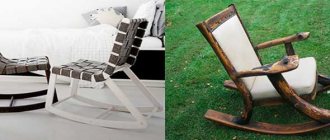In the modern world it is very difficult to surprise a person with furniture. People are spending more and more time in cafes, various offices, and other places where the decoration and furnishings are selected by very skillful and even somewhat extravagant professionals, and prices can reach astronomical values. However, some enthusiasts did not give up their attempts to furnish the room more elegantly than others. Such connoisseurs will find the idea of an egg-shaped chair made of artificial rattan useful.
A little about the history of the egg chair
Back in 1958, the famous Danish architect Arne Jacobson first used the concept of egg-shaped chairs to decorate the lobby of the Royal Hotel in Copenhagen. The basis of this piece of furniture was plastic, it was reinforced with fiberglass, covered with special furniture foam and upholstered in leather. Furniture designers liked this shape of the chairs so much that they adopted this concept. True, the range of materials has expanded, for example, many experts chose to replace plastic with aluminum, and someone very successfully used concrete to create the base!
Since then, the design of such chairs and manufacturing materials have remained without significant changes, the main thing being the shape. These days, such chairs are used in upscale hotels and business centers, and can be seen in films and TV series. The main use of an egg chair is to sit in it with your back to the door, and every time someone enters the room, you can slowly and imposingly turn to the guest with the words: “I’ve been waiting to meet you for a long time, Mister Bond.” . For an even greater resemblance to the villain from a series of popular films about the legendary British intelligence officer, it is recommended to pet a cat or smoke a cigar.
It would not be out of place to say that the egg chair was an indispensable attribute in the waiting rooms of many Western (and then Russian) psychologists and psychiatrists. In their opinion, the patient, sitting in such a chair, can immerse himself much deeper in the process of solving his problems, separated from the outside world on three sides and from above. Speakers were inserted into such a chair, from which soothing music began to flow at the right moment. Egg chairs of this design, produced several decades ago, are today the dream of every furniture collector and fetch a lot of money at auctions.
Helminthiasis
Parasitic worms found in the body of humans, animals and plants cause diseases called helminthiasis. Human parasitic worms disrupt the functioning of internal organs and the entire body as a whole, causing poor absorption of nutrients, weakness and diseases of the host body. There are three groups of worms that are classified as helminths:
- Nematodes or roundworms (pinworms, roundworms, Trichinella, Filaria, Intestinal eel);
- Trematodes or flatworms (Opisthorchis, Chinese fluke, Paragonimus, Schistosomes);
- Cestodes or tapeworms (Bovine and pork tapeworms, broad tapeworms, echinococcus, alveococcus).
Helminths have a similar morphology and are multicellular organisms that are visible to the naked eye. In their life cycle, helminths necessarily go through a number of stages: egg, larva and adult. During their life cycle, some worms change hosts. Such helminths are called biohelminths. Geohelminths are parasitic worms that do not require a change of hosts, and their life cycle occurs in the body of a single host. NEMATODOSIS Ascariasis Etiology, pathogenesis .
The causative agent is roundworm, which parasitizes in the adult stage in the small intestine. The lifespan of roundworms is about a year. In the migratory stage (the first 6–8 weeks after infection), roundworm larvae have a mechanical and sensitizing effect, causing hemorrhages and eosinophilic infiltrates in the tissues of various organs. In the intestinal phase (8 weeks after infection), adult roundworms cause general toxicoallergic and neuroreflex reactions of the body and a variety of local mechanical effects.
Symptoms, course
. The migration phase often occurs under the guise of acute respiratory infections and bronchitis; volatile eosinophilic infiltrates in the lungs are possible. In the intestinal phase, a gastrointestinal form is distinguished (salivation, nausea, loss of appetite, cramping pain around the navel, sometimes disorders of stool and gastric secretion); hypotonic (decreased blood pressure, weakness) and neurological (dizziness, headache, fatigue, sleep disturbance, vegetative-vascular disorders) forms.
Complications
. Ascariasis intestinal obstruction, a characteristic feature of which is the release of roundworms with vomit and palpation of a moving “tumor” - a ball of helminths; ascariasis appendicitis; perforated peritonitis; ascariasis of the liver with the development of jaundice, purulent angiocholitis, liver abscess, subphrenic abscess; ascariasis of the pancreas with symptoms of acute pancreatitis; crawling of roundworms into the respiratory tract with the development of asphyxia.
Diagnostics.
The diagnosis of the early phase of ascariasis is based on the detection of nematode larvae in the sputum and antibodies in the blood, and the late intestinal phase - ascaris eggs in the feces.
Prevention
.
Mass examination of the population and treatment of all those infected with ascariasis. Protection of the soil of vegetable gardens, orchards, and berry fields from contamination with feces. Thorough washing and scalding of vegetables and fruits with boiling water. Personal hygiene measures .
Hookworm disease (hookworm and necatoriasis)
Etiology, pathogenesis.
The causative agents are hookworm and necator, parasitic in the small intestines of humans, most often in the duodenum. Infection occurs when the larvae actively penetrate the skin or when they are ingested with contaminated vegetables, fruits, or water. The larvae migrate through the systemic and pulmonary circulation, lasting 7–10 days. In the small intestine, the larvae turn into sexually mature individuals and after 4–6 weeks begin to lay eggs. The lifespan of hookworms ranges from several months to 20 years. During the migration period, the larvae cause toxic-allergic phenomena. Adult helminths are hematophagous. When fixed to the intestinal mucosa, they injure tissue, lead to the formation of hemorrhage, erosion, cause bleeding, anemia, support the state of allergies, gastrointestinal dyskinesia and dyspepsia.
Symptoms, course
. Soon after infection, skin itching and burning, urticarial rashes, asthmatic phenomena, fever, and eosinophilia occur. In the late stage, nausea, drooling, vomiting, abdominal pain, intestinal dysfunction (constipation or diarrhea), and bloating appear. Sometimes pseudoulcer syndrome occurs (hunger pain in the epigastric region, hidden bleeding). The development of hypochromic iron deficiency anemia is characteristic; its severity depends on the intensity of invasion, nutritional deficiency, and individual characteristics of the organism. With low intensity, the invasion can occur subclinically, manifesting itself as eoeinophilia.
Diagnostics
. The diagnosis is confirmed by the detection of eggs in the stool and occasionally in the duodenal contents.
Prevention
. In areas of hookworm infection, you should not walk barefoot or lie on the ground without bedding. It is necessary to thoroughly wash and scald fruits, vegetables, and berries with boiling water; before eating them, you should not drink unboiled water.
Strongyloidiasis
Etiology, pathogenesis.
The causative agent is the intestinal eel, parasitizing in the intestinal wall (mainly the duodenum), sometimes in the ducts of the liver and pancreas, and during the migration period - in the bronchi and lung tissue. The penetration of Strongyloides larvae into the human body can occur actively through the skin (when walking barefoot, etc.) and through the mouth (when eating contaminated fruits, vegetables, and also when drinking water). Adult parasites, localized in the intestinal wall, injure the intestinal crypts (Lieberkühn's glands), solitary follicles and contribute to ulceration of the mucous membrane, and the larvae, migrating, damage the tissue of the liver, lungs and other organs. Of great importance is the toxic-allergic effect of adult parasites and their larvae on the human body, as well as secondary infection.
Symptoms, course
. Signs of allergy often occur: skin itching, burning, urticaria, eosinophilia, sometimes “volatile infiltrates” in the lungs, etc. In the late stage, the symptoms of gastroduodenitis, enterocolitis, and sometimes cholecystitis predominate. The typical triad is chronic recurrent urticaria, persistent enterocolitis and long-term high eosinophilia. Dizziness, headache, insomnia, and increased excitability are common. Sometimes the disease manifests itself only as eosinophilia and skin itching. The course is long, many years (until specific treatment), since with this helminthiasis (especially with constipation), autoreinvasion is possible. There are indications of a connection between hyperinvasion and the use of corticosteroids and immunosuppressive drugs. In severe forms of the disease, ulcerative enterocolitis develops with dehydration, cachexia, anemia and death.
Diagnostics
. The diagnosis is based on clinical data and the detection of acne larvae in feces (when examined using the Berman method) and in duodenal contents, less often in sputum and urine.
Trichocephalosis
Etiology, pathogenesis.
The causative agent is the whipworm, which parasitizes the human colon. The lifespan of the parasite is about 5 years. Whipworms injure the intestinal mucosa, are hematophagous and promote inoculation of microflora, causing reflex reactions in other organs of the abdominal cavity. Their metabolic products sensitize the body.
Symptoms, course
. Worries include drooling, decreased (less often increased) appetite, pain in the right half of the abdomen and epigastrium, nausea, constipation or diarrhea. There may be inflammatory phenomena in the intestines. Headache, dizziness, restless sleep, irritability are often observed; moderate hypochromic anemia and slight leukocytosis are possible. With intense invasion in children, cases of rectal prolapse (due to persistent diarrhea), epileptiform seizures, and Meniere's syndrome have been described. At low intensity, whipworm infestation is asymptomatic.
Diagnostics.
The diagnosis is made when whipworm eggs are found in the stool.
Prevention
. Mass examination of the population and treatment of all infested forms. Protection of the soil of vegetable gardens, orchards, and berry fields from contamination with feces. Thorough washing and scalding of vegetables and fruits with boiling water. Personal hygiene measures.
Trichostrongylidosis
The causative agents are small helminths from the family Trichostrongylidae. The main source of invasion is sheep, goats, and cattle. A person becomes infected through contaminated food or water.
Symptoms, course
. Characterized by nausea, abdominal pain, unstable stools, dizziness, and headache. Sometimes hypochromic or normochromic anemia and loss of strength develop. The diagnosis is based on the detection of trichostrongylid eggs in the stool.
Prevention.
Compliance with personal hygiene measures.
Trichinosis (trichinosis)
Etiology, pathogenesis
. The causative agent is Trichinella. In the larval stage, it enters the human body with the meat of pigs or wild animals (boar, bear, badger, etc.). After digestion of meat, muscle Trichinella are released from capsules, penetrate into the villi tissue, quickly grow, develop, and already 80–90 hours after infection, females lay numerous larvae, which are spread throughout the body. The place of further development of young Trichinella are the striated muscles, especially the intercostal, masticatory, muscles of the diaphragm, tongue, pharynx, and eyes. Here, after 2–3 weeks, trichinella coil up, become encapsulated, and some of them become calcified. The duration of the intestinal stage of Trichinella is about 2 months. Muscular trichinella remain viable for up to 20 years or more. The breakdown and metabolic products of Trichinella sensitize the body, causing eosinophilia, capillaropathy, muscle infiltrates, edema and other painful phenomena. The mechanical effects of adult Trichinella in the intestines and their larvae in muscles and other tissues, as well as secondary infection, are important.
Symptoms, course
. The incubation period is from 3 to 45 days. Early symptoms are characteristic: facial puffiness, accompanied by conjunctivitis, fever, muscle pain, eosinophilia. Various skin rashes are common, as well as gastrointestinal disorders, hypotension, muffled heart sounds, palpitations, headache, and insomnia. In mild forms, only eyelid swelling and eosinophilia are noted. The duration of the disease is from 2–3 days to 8 weeks or more. Sometimes a recurrent course of trichinosis is observed. Complications: myocarditis, meningoencephalitis, thrombosis of arteries and veins, pneumonia, nephritis, etc.
Diagnostics.
The diagnosis is based on epidemiological (consumption of undercooked pork and other meat, group diseases), characteristic clinical data (eosinophilia, swelling of the eyelids, fever, muscle pain). Serological reactions with trichinosis antigen are used. Confirmation of the diagnosis can be the detection of Trichinella and characteristic infiltrates in biopsied pieces of muscle (trapezius, deltoid, gastrocnemius) or in the remains of meat that caused the disease. A biopsy is performed on the 9th–10th day of illness.
Prevention.
You should not eat raw or undercooked pork, as well as the meat of wild boar, bear, badger, etc.
TREMATODOSIS Clonorchiasis
Clonorchiasis is a helminthiasis of the liver and pancreas caused by the fluke fluke. It is found among the population living in the Amur basin. Pathogenesis, clinical picture, diagnosis, treatment and prevention are the same as for opisthorchiasis.
Metagonimiasis
Metagonimiasis is a helminthiasis caused by a small trematode. The pathogen parasitizes in the small intestine of humans, dogs, cats, and pigs. Human infection occurs through consumption of raw fish. In the intestine, larvae hatch from the metacercariae of Metagonimus, which reach sexual maturity in the thickness of the mucous membrane after 2 weeks and emerge into the intestinal lumen. As a result of mechanical and toxicoallergic effects, enteritis develops.
Symptoms, course
. Abdominal pain, drooling, persistent diarrhea. Sometimes it occurs subclinically.
Diagnostics
. The diagnosis is based on the detection of Metagonimus eggs in the stool.
For prevention, see Diphyllobothriasis.
Nanophyetosis
Nanophyetosis is an intestinal helminthiasis that occurs among the population of the Far East. The causative agent is nanophyetus, which parasitizes the intestines of humans, dogs, cats, minks, and badgers. Infection occurs by eating raw fish. Helminths have a mechanical and toxic-allergic effect on intestinal tissue.
Symptoms, course.
Pain and rumbling in the abdomen, diarrhea, constipation, drooling and nausea at night.
Diagnostics
. Diagnosis is made based on the detection of nanophyetus eggs (resembling diphyllobothrid eggs) in the stool.
Treatment
. Male fern extract in a dose of 3–3.5 g.
Prevention
. You should not eat raw, uncooked or insufficiently salted and dried fish, as well as “live” pike caviar.
Opisthorchiasis
Etiology, pathogenesis
. The causative agent is the cat fluke, or Siberian fluke, which parasitizes the bile ducts of the liver, gallbladder and pancreatic ducts of humans, cats, dogs, etc. The parasite lives in the human body for 20–40 years. Infection occurs when eating raw (thawed, frozen), lightly salted and insufficiently fried carp fish (ide, chebak, dace, etc.). Opisthorchises injure the mucous membranes of the pancreatic and bile ducts, create obstacles to the outflow of bile, and contribute to the development of cystic enlargements and liver tumors. They have toxic and neuro-reflex effects. In the early stage, pronounced allergization of the body is observed (eosinophilic-leukemoid blood reactions).
Symptoms, course
. The incubation period is about 2 weeks. In the early period there may be fever, pain in muscles and joints, vomiting, diarrhea, pain and enlargement of the liver, less often the spleen, leukocytosis and high eosinophilia, allergic skin rashes. In the chronic stage, the most common complaints are pain in the epigastric region, right hypochondrium, radiating to the back and left hypochondrium. Sometimes there are attacks of pain such as gall bladder colic. Frequent dizziness and various dyspeptic symptoms. Muscle resistance in the right hypochondrium, liver enlargement, occasionally icteric sclera, enlarged gallbladder, and symptoms of pancreatitis are detected. Most often, with opisthorchiasis, the phenomena of angiocholitis, cholecystitis, biliary dyskinesia, chronic hepatitis and pancreatitis develop, and less often - symptoms of gastroduodenitis and enterocolitis. In some cases, a picture of cholangitic cirrhosis of the liver occurs. Opisthorchiasis can be asymptomatic.
Diagnostics
. The diagnosis is based on the detection of helminth eggs in the stool and duodenal contents.
Prevention
. Explaining to the population the dangers of eating raw, thawed and frozen (stroganina), lightly salted and insufficiently fried fish.
Fascioliasis
Etiology, pathogenesis.
Pathogens: liver fluke and giant fluke. The main source of human invasion is various farm animals. Human infection usually occurs in the warm season when fasciola larvae are ingested in water, sorrel, lettuce and other greens. The lifespan of helminths in the body is about 10 years. Trauma and toxic-allergic damage to the hepatobiliary system are important. Fasciolae can be carried into other tissues and organs.
Symptoms, course
. The disease is characterized by eosinophilia, allergic phenomena, disorders of the liver and gall bladder, reminiscent of the symptoms of opisthorchiasis (jaundice and attacks of gall bladder colic are more common).
Diagnostics
. Diagnosis of the early stage of fascioliasis is difficult, since helminth eggs are released only 3–4 months after infection. Immunological methods are used. In the late stage, the diagnosis is based on the detection of fasciola eggs in the duodenal contents and feces.
Prevention
.
Prohibition of drinking water from stagnant bodies of water; Thoroughly washing and scalding the greens with boiling water. CESTODOSES Alveococcosis Etiology, pathogenesis.
The causative agent is the larval stage of alveococcus. Infection occurs after oncospheres enter the mouth after contact with contaminated skins of foxes, arctic foxes, dogs, with the water of stagnant reservoirs and by eating wild berries collected in endemic areas. Clusters of larvae (usually in the liver) infiltrate and grow into tissues, disrupt the blood supply to organs, cause tissue degeneration and atrophy, and have a toxic-allergenic effect.
Symptoms, course
. The disease develops slowly and remains asymptomatic for a long time. There is a progressive enlargement of the liver, heaviness and pressure appear in the right hypochondrium, and a dull aching pain. After a few years, the liver becomes lumpy and very dense. Jaundice may develop. The spleen often becomes enlarged. Possible ascites. When the nodes disintegrate, body temperature rises, sweating, leukocytosis, eosinophilia, and increased ESR are observed. Hyperproteinemia and hypergammaglobulinemia are characteristic. Necrotization and invasion into the inferior vena cava can lead to profuse bleeding. With metastases to the lungs, symptoms of pneumonia, bronchitis, and hemoptysis may occur. Brain metastases mimic the clinical picture of a brain tumor.
Diagnostics.
Diagnosis is based on clinical data. Serological tests with alveococcal antigen are performed. To clarify the localization, X-ray and ultrasound examination, liver scanning, peritoneoscopy, and computed tomography are used. Test puncture is strictly prohibited due to the risk of contamination of other organs. Differentiate from tumors, echinococcosis and cirrhosis of the liver.
Hymenolepiasis
Etiology, pathogenesis
. The causative agent is the dwarf tapeworm. Infection occurs through ingestion of parasite eggs that come into contact with the patient and with contaminated feces, household items (chamber pots, toilet seats, etc.) and restroom walls. The local effect of larvae and adult forms on the intestinal mucosa is expressed in the destruction of villi, proliferative inflammation (sometimes with ulceration) of the mucous membrane with copious secretion of mucus. Toxic-allergic effects are also observed.
Symptoms, course
. Decreased appetite, nausea, abdominal pain, diarrhea or constipation, dizziness, headache, irritability, increased fatigue, restless sleep. Sometimes weight loss, moderate anemia, and eosinophilia are observed. Hymenolepidosis can be asymptomatic.
Diagnostics _
. The diagnosis is made based on the detection of dwarf tapeworm eggs in the feces.
Prevention
. Maintaining hygiene of the body, clothing, home, and public hygiene. Examination of all members of the patient’s family for helminths and simultaneous treatment of all infested ones.
Diphyllobothriasis
Etiology, pathogenesis
. The causative agent is the broad tapeworm. Its lifespan is tens of years. Human infection occurs when eating fresh, insufficiently salted caviar and raw fish (pike, perch, omul, grayling, etc.). The tapeworm, attaching to the intestinal mucosa with its bothria, injures it. Large accumulations of the parasite can clog the intestinal lumen. Helminth metabolic products sensitize the body. Absorption of vitamin B12 by the broad tapeworm directly from the digestive tract leads to hypovitaminosis B12 and the development of anemia.
Symptoms, course
. Characterized by nausea, unstable stools, and the release of fragments of strobili during defecation. Patients sometimes complain of weakness, dizziness, and abdominal pain. Occasionally, pernicious anemia develops, close to Addison-Birmer anemia.
Diagnostics
. The diagnosis is made by detecting tapeworm eggs and strobila fragments in the feces.
Prevention
. You should not eat raw, uncooked or insufficiently salted and dried fish, as well as “live” pike caviar.
Taeniasis
Etiology. The causative agent is the pork tapeworm, which can parasitize humans not only in the sexually mature stage, but also in the larval stage, causing the disease cysticercosis. The adult helminth parasitizes the small intestine for many years. Humans become infected with taeniasis by eating raw or half-raw meat containing taeniasis.
Symptoms, course.
The same as with teniarhynchosis, however, the segments of the parasite do not actively come out of the anus (occasionally, tender segments come out with feces, which the patient usually does not notice).
Diagnostics
. The diagnosis is made on the basis of repeated examination of stool for the presence of helminth segments and mucus from the perianal folds (by scraping) for the presence of tapeworm eggs.
Prevention.
You should not eat undercooked or undercooked pork.
Chairs with floor support
The main versions of the egg chair are made exclusively with support on the floor. The chair itself can rotate in different directions, and the support can either be firmly attached to the floor, or it can be made so massive that the chair does not turn over during rotation if the “load” is unevenly distributed. However, the chair is fundamentally designed in such a way that it is simply impossible to “distribute” it unevenly. It is comfortable in all respects, and once you sit down in it, you don’t have to look for the most comfortable position – the chair will find it for its client’s body on its own.
The main advantage of such a chair is its unique shape, which takes into account the smallest details of human anatomy. It’s simply impossible not to feel comfortable in it! An unsurpassed level of comfort, combined with an unusual, eye-catching design, makes the egg-shaped chair an excellent solution for both the office, reception area and living space.
Egg-shaped hanging chairs
Rocking chairs made in the above-mentioned form, but instead of resting on the floor, are attached to the ceiling have enjoyed particular success recently. This concept appeared a little later than the original, and is not much inferior to it. Depending on the type of support or fixation, hanging chairs are divided into three types.
Hanging chairs to the ceiling
This chair is usually attached to the ceiling. An ideal option for a child’s room, because it’s a full-fledged swing right in the room! Of course, this type of hanging chair requires space in the room, otherwise you might accidentally break something or hit the wall. Also, to install such a chair, you will need to install a special hook, and not every owner will agree to such metamorphoses of his home. But there is a way out that provides beauty that does not require sacrifice. For people who do not want to drill additional holes in their room, or who do not have the opportunity to provide space, the designers have provided the following type of chair.
Hanging rocking chairs on a ready-made mount
With this design, the chair is suspended on a metal frame, which is placed on the floor. This combination ensures the mobility of the chair and does not require additional interventions in the interior, while maintaining a high level of comfort.
Combined options
Maximum static chairs that are attached to the floor and ceiling at the same time. For what? Nobody knows why. But it looks provocative!
Each owner chooses the type of chair, depending on the room in which they plan to install the egg-shaped chair. The latter differ not only in the type of fastening, but also in size, style and material from which they are made. Most egg-shaped hanging chairs are made from durable and soft-touch faux rattan or plastic. But the most capricious collectors can find a chair made of wood, aluminum or steel. By the way, all egg-shaped chairs contain a small amount of metal parts. Depending on the style and type of chair, some of them are not so much constructive as decorative.
The shape of the chair most often resembles an egg, but there are also options that have a more rounded shape. There is no fundamental difference between them, the choice of the shape of the chair is subjective, the buyer himself will make a choice in favor of the shape he likes.
Types of baskets
Hanging chairs come in a variety of shapes, materials, styles and color variations. In the catalog you will find models:
- "Cocoon". The design has a high back and side surfaces that connect above the head. The product has a rigid frame.
- "Egg". It differs from the previous type in a more elongated shape. The model is used when decorating rooms in a Scandinavian style.
- "Ball". It is half a ball (sometimes more), which is why it gets its name. Original and functional form.
- "Nest". The design is based on two strong hoops. It has a flat bottom and low sides braided with cord.
Our chairs are functional, mobile, aesthetic and, of course, practical. In addition, they are complemented by soft pillows and mattresses, classic calm colors or bright shades.
What to look for when purchasing
Each chair has its own weight limit that it can support. Most models will withstand up to 120 kilograms of load, but it is better to make sure of its real strength in advance. It is also worth choosing the material based on the climatic conditions of the room. Not all materials can withstand high humidity or dry air; not all chairs like constant exposure to sunlight or a location close to a window. It is better to discuss such nuances with the seller before purchasing. It would be a shame if a chair purchased for a lot of money does not last long. And the price of such chairs is really quite high!
In general, we can say that an egg-shaped chair of any type, style and design will definitely attract attention. However, the owner should coordinate it with the interior, because a chair located in an inappropriate environment can cause not delight, but a completely opposite effect. But if the egg chair is installed in harmony with the decor, guests who have sat on this chair once will try to visit more often.











